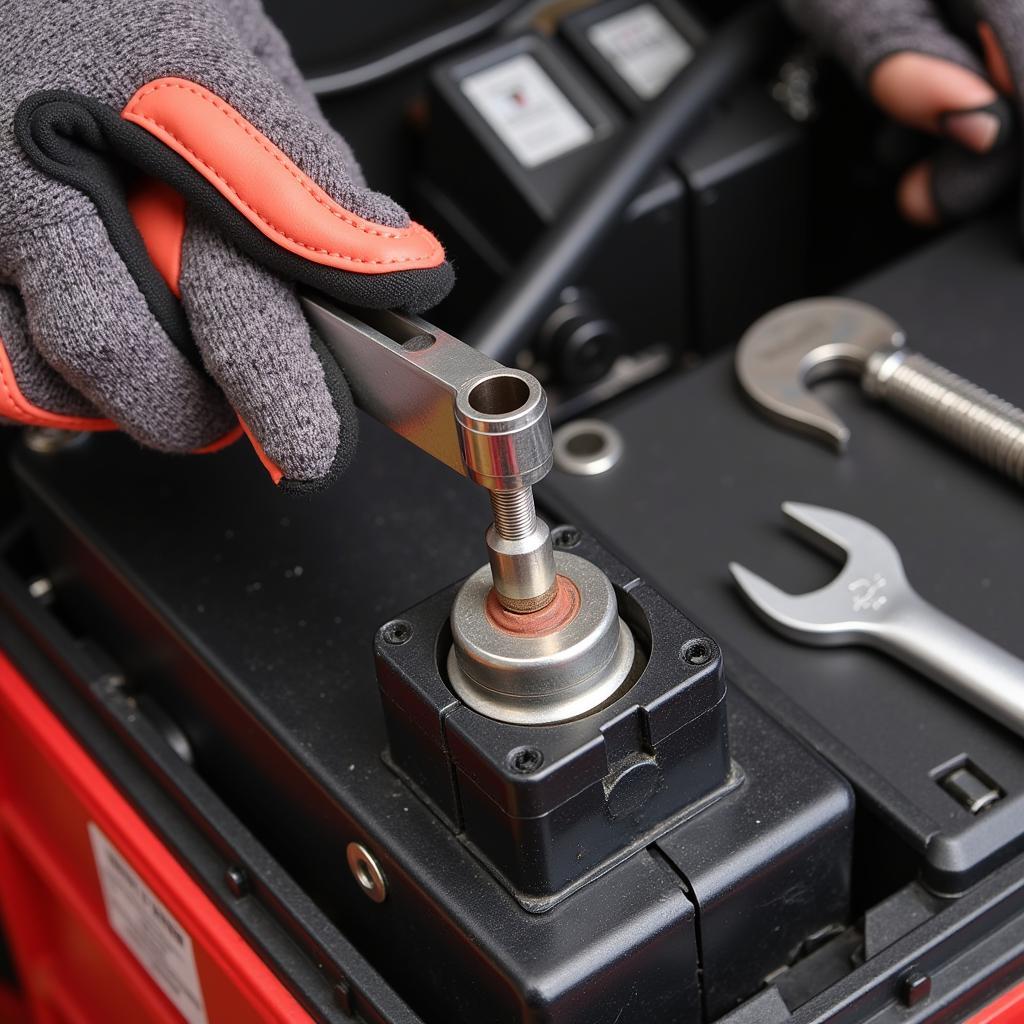Replacing your car battery terminals is a crucial maintenance task that ensures your vehicle starts reliably. While it might seem daunting, understanding the right Replace Car Battery Terminal Tools and procedures can make the job straightforward and safe. This guide will provide you with everything you need to know about replacing your car battery terminals, from the necessary tools to step-by-step instructions.
Why Replace Your Car Battery Terminals?
Corrosion is the primary culprit behind faulty battery terminals. Over time, battery acid can react with the metal terminals, forming a buildup that hinders the flow of electricity. This can lead to starting problems, dimming headlights, and other electrical issues. Replacing corroded terminals ensures a clean connection and optimal performance.
After this introductory section, let’s dive into the tools you will need. If you are unsure about replacing a distributor, you can check out this helpful guide: tools needed to replace distributor in car.
Essential Replace Car Battery Terminal Tools
Having the correct tools makes the job easier and safer. Here’s a list of essential replace car battery terminal tools:
- Wrench: Use the correct size wrench for your battery terminal nuts.
- Terminal Puller: This tool helps remove stubborn terminals without damaging the battery posts.
- Wire Brush: Use a wire brush to clean corrosion from the battery posts and terminals.
- Battery Terminal Cleaner: A specialized cleaner can effectively remove stubborn corrosion.
- Safety Glasses and Gloves: Always protect your eyes and hands when working with car batteries.
- Dielectric Grease: Applying dielectric grease to the new terminals prevents future corrosion.
- New Battery Terminals: Ensure you purchase the correct type and size for your vehicle.
What are the Signs of Bad Battery Terminals?
Several signs indicate your battery terminals need attention. These include:
- Difficulty starting the engine
- Dim headlights or interior lights
- Clicking sound when turning the key
- Visible corrosion on the terminals
Understanding how to care for your tools is crucial for their longevity. Check out this guide on proper battery care: how to care for lithium ion tool batteries.
Step-by-Step Guide to Replacing Car Battery Terminals
Follow these steps to safely and effectively replace your car battery terminals:
- Disconnect the Negative Cable: Always disconnect the negative cable first to prevent short circuits.
- Disconnect the Positive Cable: After the negative cable is removed, disconnect the positive cable.
- Clean the Battery Posts: Use a wire brush and battery terminal cleaner to remove any corrosion from the battery posts.
- Install the New Terminals: Attach the new terminals to the battery posts and tighten them securely.
- Reconnect the Positive Cable: Reconnect the positive cable first, followed by the negative cable.
- Apply Dielectric Grease: Apply a thin layer of dielectric grease to the terminals to prevent future corrosion.
 Replacing a Car Battery Terminal: A Step-by-Step Process
Replacing a Car Battery Terminal: A Step-by-Step Process
How to Choose the Right Replace Car Battery Terminal Tools
Choosing the right tools ensures a successful replacement. Look for high-quality tools made from durable materials. The correct size wrench is crucial for a proper fit, and a terminal puller can prevent damage to the battery.
Having the right tools in your car for emergencies can be invaluable. Here’s a list of essentials: essential car tools trunk.
Benefits of Using Proper Replace Car Battery Terminal Tools
Using the right tools provides several advantages:
- Safety: Prevents accidental short circuits and damage to the battery.
- Efficiency: Makes the replacement process quicker and easier.
- Prevents Damage: Reduces the risk of damaging the battery posts or terminals.
- Long-Term Reliability: Ensures a secure and corrosion-free connection.
It’s worth noting that while battery terminals are important, maintaining other tools is equally crucial. Consider this guide for your everyday essentials: tooth care tools.
Conclusion
Replacing car battery terminals is a manageable task with the right replace car battery terminal tools and knowledge. This guide has provided you with the necessary information to confidently tackle this essential maintenance procedure, ensuring your vehicle’s electrical system performs optimally. By following these steps and using the correct tools, you can extend the life of your battery and avoid potential starting problems.
Having a reliable battery is essential for a well-functioning vehicle. Here’s a comprehensive guide on replacing car battery cables: tools needed to replace car battery cables.
FAQ
- How often should I replace my car battery terminals? Replace them when they show signs of significant corrosion or damage.
- Can I replace car battery terminals myself? Yes, it’s a relatively simple DIY task.
- What is the purpose of dielectric grease? It prevents corrosion by creating a barrier between the terminal and the post.
- What are the signs of a bad car battery? Difficulty starting, dim lights, and a clicking sound when turning the key.
- What size wrench do I need for car battery terminals? The size varies depending on the vehicle, but 10mm and 13mm are common.
- Can corroded terminals damage my battery? Yes, corrosion can hinder the flow of electricity and shorten the battery’s lifespan.
- What should I do if my car battery terminals keep corroding? Ensure the battery is properly sealed and consider using a battery terminal protector.
Need further assistance? Contact us via WhatsApp: +1(641)206-8880, Email: cardiagtechworkshop@gmail.com or visit our workshop at 910 Cedar Lane, Chicago, IL 60605, USA. Our 24/7 customer service team is ready to help.

Leave a Reply